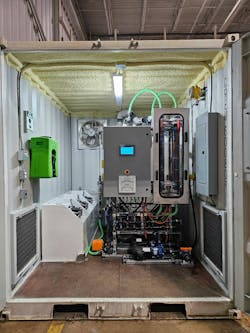How onsite electrochemical oxidation demineralizes and destroys PFAS
Per- and polyfluoroalkyl substances (PFAS) are among the most useful synthetic chemical compounds ever created. Unfortunately, the same properties that make these compounds so incredibly effective in such a broad range of applications also pose a potential threat to human health. Until other substances that match PFAS performance are invented, manufacturers need strategies that allow for the safe continued use and onsite destruction of PFAS compounds to sustain their existing businesses. The challenge is keeping PFAS where they are helpful and removing them from where they are harmful.
PFAS are complex chemical compounds that were invented to last forever. Their resistance to degradation has been a challenge for chemical engineers, but a more thorough understanding and technological advances are delivering breakthroughs and ushering in a new era of contaminant remediation. Breaking the cycle of reintroduction is the only way to significantly reduce their widespread presence in the environment and limit their existence to beneficial use.
The state of PFAS regulations
PFAS regulations are a bit of a moving target at present. Most of the media attention around PFAS regulations has focused on drinking water regulations, but other federal regulations directly impact industrial wastewater. Currently, the Comprehensive Environmental Response, Compensation, and Liability Act (CERCLA), finalized in July 2024, designates PFOA and PFOS as hazardous substances. This authorizes the EPA to order cleanups at sites contaminated with PFOA and PFOS, recover cleanup costs from responsible entities and require reporting of releases of these two PFAS. While federal reportable quantities are still in the proposal phase, this regulation already establishes liability for entities that release any level of PFAS into the environment, exposing industrial sites to lawsuits filed by third parties such as property owners, city governments and others claiming damage from the contamination.
Under the Clean Water Act, industrial sites are held to effluent limitation guidelines (ELGs) and requirements of the National Pollutant Discharge Elimination System (NPDES) permit. While many of these standards for PFAS also are still under review, most industries will find compliance a more affordable risk strategy than rolling the dice on choosing to release PFAS that are above proposed standards.
The more pressing regulatory landscape actually is on the state level, where regulations in some states are more stringent than federal regulations. For example, the Wisconsin Supreme Court recently sided with state environmental regulators, confirming their authority to address PFAS contamination under Wisconsin’s spills law without first designating them as hazardous substances. Local jurisdictions are weighing in too, especially as it concerns industrial wastewater being sent to municipal treatment plants — in fact, some municipal treatment plants are starting to refuse waste streams contaminated with PFAS or requiring pretreatment, driving up costs for industrial facilities. Around a dozen states also have passed bans on PFAS in certain categories of consumer products. Companies with facilities in multiple states and cities must keep track of the wide array of regulations that affect their operations.
The best strategic move for industry is to keep abreast of PFAS regulatory trends and proactively destroy waste PFAS. By staying ahead of the regulations and demonstrating responsibility in comprehensive PFAS waste destruction, companies can ensure that PFAS can continue to be commercially available for the products that people depend on.
Emerging technology focuses on destruction
As it has done for generations, the water treatment industry is rising to the PFAS challenge. Our industry has consistently attracted engineering talent that is drawn to solving tough water treatment problems for both the intellectual reward and the humanitarian benefits that good solutions provide.
Conventional PFAS remediation focuses on the use of filtration and adsorption through granular activated carbon (GAC) or ion exchange (IX) resin. While highly effective at removing PFAS from water, these technologies only move the PFAS from one place (water) to another (filter media). Once trapped in the filter media, companies incur the cost of spent media waste hauling and/or destruction, during which time PFAS have the great potential to reenter the environment. Permanent destruction of PFAS compounds at the source is the only way to break this cycle.
New destruction technologies that have progressed beyond the laboratory scale include supercritical water oxidation (SCWO), hydrothermal alkaline treatment (HALT) and electrochemical oxidation (EOx). The regulatory compliance and risk management benefits of proven PFAS destruction methods are significant, because the technology can deliver a waste stream that is cleaner than the source water.
SCWO applies extreme heat and pressure to drive water to a supercritical fluid — allowing organic contaminants, including PFAS, to be oxidized into harmless end products. HALT uses a lesser amount of heat and pressure combined with a high pH environment to attack the carbon-fluorine bond that makes PFAS so stable.
The most commercially deployed and proven technology is electrochemical oxidation (EOx). EOx uses direct electricity to directly destroy PFAS at ambient temperature and pressure. As a result, in most applications it consumes much less energy than SCWO or HALT. Additionally, the process is the least complex of the three methods, which means it is simpler to deploy and requires less operator interaction.
How electrochemical oxidation works
EOx immerses a reactive metal plate in the treatment stream and applies electrical energy, setting off a series of oxidation and reduction reactions that can be maintained as long as desired to achieve the target PFAS destruction level. PFAS molecules are designed to resist oxidation and degradation, but in an electrochemical system, the electrical potential on the anode surface is high enough to begin oxidizing the PFAS molecules. Once they are partially oxidized, they are more vulnerable to oxidants in the system. They will then begin alternately reacting with the anode and then with the oxidants, until all the carbons and fluorines are sequentially stripped off, reducing long-, short- and ultrashort-chain PFAS to their elemental components. This process completely mineralizes PFAS to carbon dioxide, hydrogen gas, fluorine ions and mineral salts, with zero waste products.
Depending on the starting concentrations, EOx can be used as a sole technology or coupled with upstream concentration technologies such as reverse osmosis (RO), foam-fractionation (FF) or ion-exchange (IX) to achieve the most cost-effective strategy to destroy PFAS, solvents and other complex organics onsite. Onsite destruction dramatically reduces or eliminates the need for expensive waste hauling and disposal that is typically required of PFAS concentration technologies and prevent the environmental reintroduction of PFAS through landfilled or incinerated spent media.
Axine EOx technology
EOx technology from Axine Water Technology can achieve up to 99.999% destruction and surpass the requirements of even the most stringent pollution regulations, which may be desirable for some industries. Other industries may be satisfied with 99.9% destruction, and setting different target levels is essentially a factor of how much and how long energy is applied to the treatment water. Facilities therefore can make a cost-benefit decision on the level of destruction they want to achieve.
Another way the system can be adapted to specific effluent challenges is in the selection of different electrode materials in the same system at the same time. Specific PFAS and other complex organic contaminants can be better targeted through specific chemical reaction pathways using different materials, meaning that EOx can operate at the most efficient point to achieve target destruction without wasting energy or materials or creating unwanted by-products.
The use of electrolysis, rather than heat and pressure, offers significantly reduced energy consumption, leading to potential cost savings. No hazardous chemicals are required to facilitate the oxidation process, and no solid or liquid waste is generated.
EOx technology is quite simple and requires very little operator interaction. In contrast, thermal oxidation such as SCWO is a complicated technology that requires special handling and operator understanding, and its high energy demand prevents it from being a fit for a range of applications.
Most valuable of all benefits is perhaps system adaptability. EOx can destroy long-, short- and ultrashort-chain PFAS, active pharmaceutical ingredients (APIs) and any other complex organic compound. This makes EOx a highly versatile technology for a wide range of industrial waste and regulatory demands. It offers solutions to today’s immediate problems and future challenges too.
Case study: An automotive component supplier gets ahead of regulations
Of the four PFAS destruction systems currently deployed at scale in the United States, three of them are EOx systems from Axine Water Technology.
One customer is a large automotive component supplier in the Midwest that recognized the potential impact of pending regulation and decided to proactively explore PFAS destruction technology. The company was already capturing and concentrating PFAS using onsite foam fractionation, but to mitigate long-term risks and costs associated with offsite disposal, the company sought on-site destruction solutions and identified Axine’s EOx system, electraCLEAR.
The project was initiated in 2023 with a laboratory-scale test on a 10-gallon sample of concentrated wastewater containing 69,900-82,900 ppb of various PFAS and precursor compounds. These tests showed >99.99% destruction of total detectable PFAS to below analytical detection limits using several different electrode combinations. The company then proceeded with pilot-scale testing at a manufacturing site in west Michigan using a fully containerized pilot unit that could easily run parallel to the existing wastewater treatment process. Concentrated waste was collected in 325-gallon totes for the electrochemical destruction process, allowing independent optimization of both systems.
Pilot testing demonstrated 99.9%-99.999% destruction of all PFAS and precursor compounds in the concentrated foamate. Total organic precursor (TOP) analysis showed no substantial precursors remaining in the treated water. Based on these results, the company proceeded with full-scale design of PFAS concentration and electraCLEAR destruction systems at multiple manufacturing sites in 2024 and 2025.
EOx is proven for the safe destruction of complex contaminants
Manufacturing verticals are adding on-site PFAS destruction systems to eliminate liability, reduce operational risk and meet regulatory compliance without passing the problem to the following year, another entity or the next generation. The demineralization of complex organic compounds is the only way to truly break the costly cycle of industrial waste.
About the Author

Louis LeBrun
Vice President at Axine
Louis LeBrun brings over 25 years of experience in water and wastewater technology commercialization to the Axine team. Before joining Axine, he founded AqualytX, LLC, providing commercialization support and consultation to water technology companies and investors worldwide. With leadership roles at Hoganas Environment Solutions, X-Flow (Pentair), and Parkson Corporation, Louis has a strong track record across a broad range of process technologies. Louis holds BS and MS degrees in Civil Engineering from North Carolina State University, an MBA from Duke University, and is a licensed Professional Engineer in multiple states. His diverse background and expertise drive innovation and growth at Axine in water and wastewater treatment.

